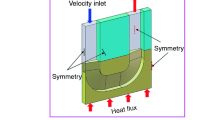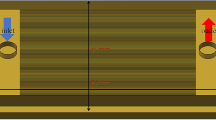Abstract
This paper reports computational research on forced convection air cooling of high thermal conductivity printed circuit boards for dissipating high heat fluxes. Flowing air velocities of 2–6 m/s are used at uniform heat flux values. The full three-dimensional, steady, laminar, incompressible, developing flow are studied. Finite element-based commercially available Comsol Multiphysics 4.3 b software is used to solve Navier–Stokes equations to study the coupling between heat transfer in solids and fluids. Single-layer and multi-layered copper clad boards having thermal conductivities of 8.8 and 40.5 W/m K, respectively, are considered as substrate materials. Effect of thermal conductivity on heat transfer characteristics under forced convection air cooling has been studied. Fifteen aluminum discrete square heat sources of sizes \(15\times 15 \times 5\) mm each are mounted on the substrate board that mimics electronic chips on printed circuit boards. Two different thermal conductivity substrate boards mounted with aluminum heat sources are considered for high heat flux values of 4000, 8000, 12,000 \(\hbox {W/m}^2\), respectively. Results of temperature plots show that a multilayer copper clad board is suitable for all high heat flux values considered for the configuration used in this study. Single-layer copper clad substrate board is capable of dissipating heat from electronic components efficiently for the heat flux values of 4000–12000 \(\hbox {W/m}^2\) except in case of high heat flux value of 12,000 \(\hbox {W/m}^2\) with a velocity of 2 m/s.




Similar content being viewed by others
References
M.M. Mohamed, Air cooling characteristics of a uniform square modules array for electronic device heat sink. Appl. Therm. Eng. 26(5), 486–493 (2006). https://doi.org/10.1016/j.applthermaleng.2005.07.013
B. Feijó, G. Lorenzini, L. Isoldi, L. Rocha, J. Goulart, E. dos Santos, Constructal design of forced convective flows in channels with two alternated rectangular heated bodies. Int. J. Heat Mass Transf. 125, 710–721 (2018). https://doi.org/10.1016/j.ijheatmasstransfer.2018.04.086
W. Thepsut, N. Pratinthong, Numerical and experimental investigation on heat transfer of multi-heat sources mounted on an array of printed circuit boards in a rectangular case. Appl. Therm. Eng. 156, 156–167 (2019). https://doi.org/10.1016/j.applthermaleng.2019.04.032
B. Sarper, M. Saglam, O. Aydin, M. Avci, Natural convection in a parallel-plate vertical channel with discrete heating by two flush-mounted heaters: effect of the clearance between the heaters. Heat Mass Transf. 54(4), 1069–1083 (2018). https://doi.org/10.1007/s00231-017-2203-4
B. Premachandran, C. Balaji, Conjugate mixed convection with surface radiation from a horizontal channel with protruding heat sources. Int. J. Heat Mass Transf. 49(19), 3568–3582 (2006). https://doi.org/10.1016/j.ijheatmasstransfer.2006.02.044
B. Premachandran, C. Balaji, Conjugate mixed convection with surface radiation from a vertical channel with protruding heat sources. Numer. Heat Transf. Part A Appl. 60(2), 171–196 (2011). https://doi.org/10.1080/10407782.2011.588577
M.M. Rashidi, N. Rahimzadeh, M. Ferdows, M.J. Uddin, O.A. Bég, Group theory and differential transform analysis of mixed convectionheat and mass transfer from a horizontal surface with chemical reaction effects. Chem. Eng. Commun. 199(8), 1012–1043 (2012). https://doi.org/10.1080/00986445.2011.636850
R. Mohebbi, M. Rashidi, M. Izadi, N.A.C. Sidik, H.W. Xian, Forced convection of nanofluids in an extended surfaces channel using lattice boltzmann method. Int. J. Heat Mass Transf. 117, 1291–1303 (2018). https://doi.org/10.1016/j.ijheatmasstransfer.2017.10.063
Y. Ma, R. Mohebbi, M. Rashidi, Z. Yang, Study of nanofluid forced convection heat transfer in a bent channel by means of lattice Boltzmann method. Phys. Fluids 30(3), 032001 (2018)
A. Rashad, M. Rashidi, G. Lorenzini, S.E. Ahmed, A.M. Aly, Magnetic field and internal heat generation effects on the free convection in a rectangular cavity filled with a porous medium saturated with cu-water nanofluid. Int. J. Heat Mass Transf. 104, 878–889 (2017)
M. Sheikholeslami, K. Vajravelu, M.M. Rashidi, Forced convection heat transfer in a semi annulus under the influence of a variable magnetic field. Int. J. Heat Mass Transf. 92, 339–348 (2016). https://doi.org/10.1016/j.ijheatmasstransfer.2015.08.066
T. Sudhakar, C. Balaji, S. Venkateshan, Optimal configuration of discrete heat sources in a vertical duct under conjugate mixed convection using artificial neural networks. Int. J. Therm. Sci. 48(5), 881–890 (2009)
T.V.V. Sudhakar, A. Shori, C. Balaji, S.P. Venkateshan, Optimal heat distribution among discrete protruding heat sources in a vertical duct: a combined numerical and experimental study. J. Heat Transf. 132(1), 011401 (2009). https://doi.org/10.1115/1.3194762
S. Durgam, S. Venkateshan, T. Sundararajan, Experimental and numerical investigations on optimal distribution of heat source array under natural and forced convection in a horizontal channel. Int. J. Therm. Sci. 115, 125–138 (2017)
S. Durgam, S. Venkateshan, T. Sundararajan, Conjugate forced convection from heat sources on substrates of different thermal conductivity. J. Thermophys. Heat Transf. 33(4), 957–969 (2019). https://doi.org/10.2514/1.T5734
S. Durgam, S. Venkateshan, T. Sundararajan, A novel concept of discrete heat source array with dummy components cooled by forced convection in a vertical channel. Appl. Therm. Eng. 129, 979–994 (2018)
S. Durgam, S. Venkateshan, T. Sundararajan, M. Nandgaonkar, P.D. Sawarkar, A. Durgam, Placement of heated blocks under forced convection for enhanced heat transfer, in Advances in Mechanical Engineering, Lecture Notes in Mechanical Engineering, ed. by V. Kalamkar, K. Monkova (Springer, Singapore, 2021). https://doi.org/10.1007/978-981-15-3639-7_8
S. Ramadhyani, D. Moffatt, F. Incropera, Conjugate heat transfer from small isothermal heat sources embedded in a large substrate. Int. J. Heat Mass Transf. 28(10), 1945–1952 (1985)
J. Davalath, Y. Bayazitoglu, Forced convection cooling across rectangular blocks. J. Heat Transf. 109(2), 321–328 (1987)
A. Rosas, R. Ali, A. Abdel-Aziz, K. Elshazly, An experimental investigation of convective heat transfer enhancement in electronic module using curved deflector. Heat Mass Transf. 53(3), 985–994 (2017)
S.K. Wang, T.-C. Hung, B.-S. Pei, A.-F. Chen, J.-L. Du, A numerical study of the enhancement of chip cooling via a flow-disturbing obstruction block. J. Electron. Packag. 127(4), 523–529 (2005). https://doi.org/10.1115/1.2070089
T. Antonini Alves, P.H.D. Santos, M.A. Barbur, An invariant descriptor for conjugate forced convection-conduction cooling of 3d protruding heaters in channel flow. Front. Mech. Eng. 10(3), 263–276 (2015). https://doi.org/10.1007/s11465-015-0345-y
M. Faraji, H. El Qarnia, E.K. Lakhal, Thermal analysis of a phase change material based heat sink for cooling protruding electronic chips. J. Therm. Sci. 18(3), 268–275 (2009). https://doi.org/10.1007/s11630-009-0268-1
A.P. Shah, Y.M. Krishna, C.G. Rao, Conjugate convection with surface radiation from a square-shaped electronic device with multiple identical discrete heat sources. J. Inst. Eng. (India) Ser. C 94(2), 123–133 (2013). https://doi.org/10.1007/s40032-013-0068-y
S.S. Tewari, Y. Jaluria, Mixed convection heat transfer from thermal sources mounted on horizontal and vertical surfaces. J. Heat Transf. 112(4), 975–987 (1990). https://doi.org/10.1115/1.2910509
C.G. Rao, C. Balaji, S. Venkateshan, Effect of surface radiation on conjugate mixed convection in a vertical channel with a discrete heat source in each wall. Int. J. Heat Mass Transf. 45(16), 3331–3347 (2002)
R. Rachedi, S. Chikh, Enhancement of electronic cooling by insertion of foam materials. Heat Mass Transf. 37(4), 371–378 (2001). https://doi.org/10.1007/s002310100192
P. Huang, C. Yang, J. Hwang, M. Chiu, Enhancement of forced-convection cooling of multiple heated blocks in a channel using porous covers. Int. J. Heat Mass Transf. 48(3), 647–664 (2005). https://doi.org/10.1016/j.ijheatmasstransfer.2004.07.041
M.G. Ghorab, Forced convection analysis of discrete heated porous convergent channel. Heat Transf. Eng. 36(9), 829–846 (2015)
Comsol, COMSOL Multiphysics: Version 5.4, Comsol, 2018
Acknowledgements
The author acknowleges his gratitude to Indian Institute of Technology Madras, Chennai for providing sofisticated computing facitities to carry out the present simulation work.
Author information
Authors and Affiliations
Corresponding author
Additional information
Publisher's Note
Springer Nature remains neutral with regard to jurisdictional claims in published maps and institutional affiliations.
Rights and permissions
About this article
Cite this article
Durgam, S. Forced Convection from IC Chips on Printed Circuit Boards Generating High Heat Fluxes. J. Inst. Eng. India Ser. C 102, 933–940 (2021). https://doi.org/10.1007/s40032-021-00704-9
Received:
Accepted:
Published:
Issue Date:
DOI: https://doi.org/10.1007/s40032-021-00704-9




